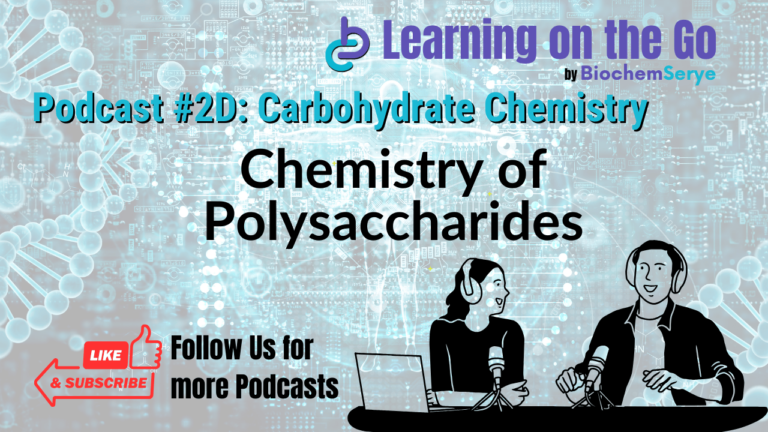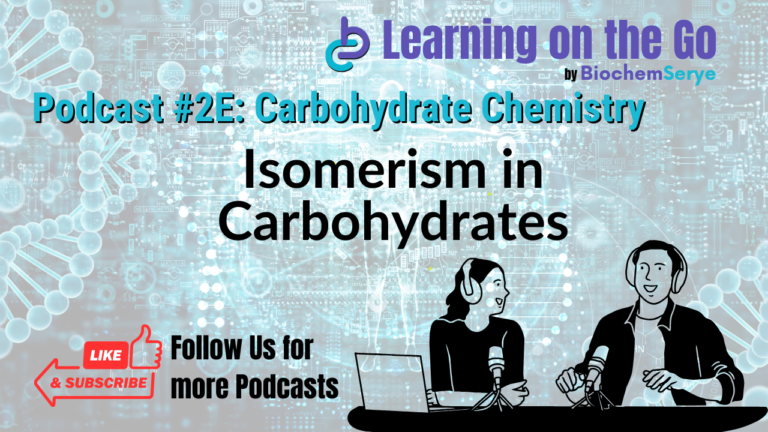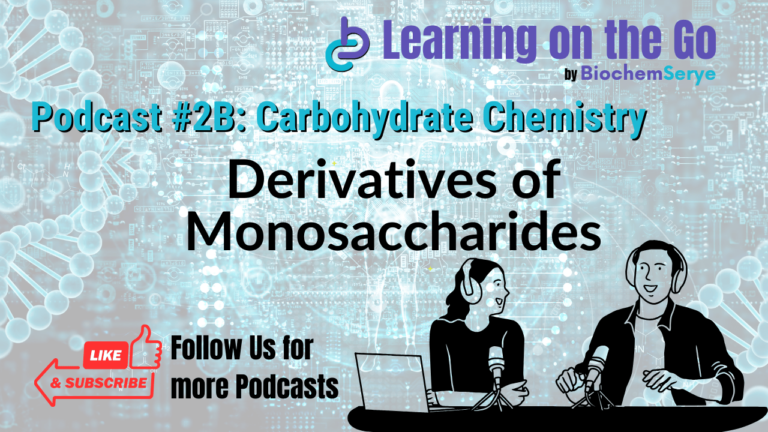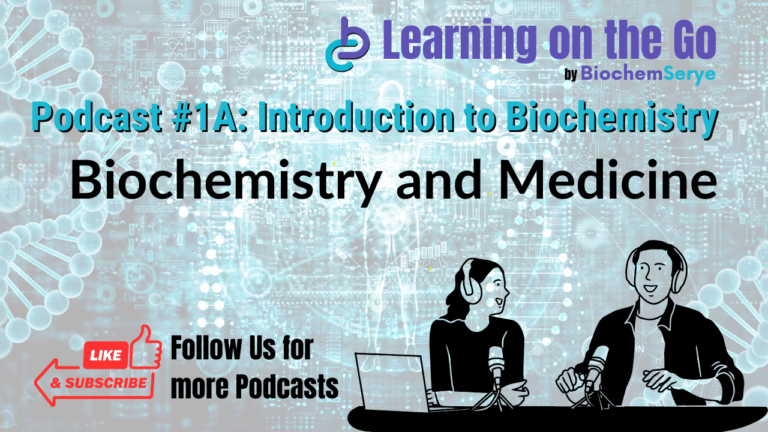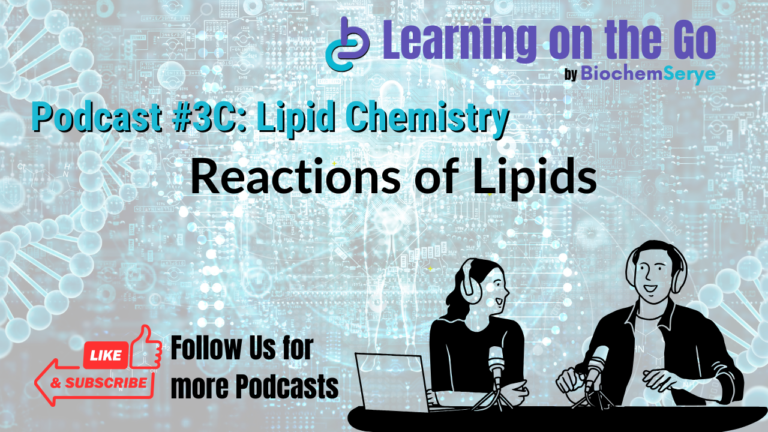Chemistry of Disaccharides Biochemistry Notes
Chemistry of Disaccharides Biochemistry Notes
The Chemistry of Disaccharides Biochemistry Notes explains the structure and properties of disaccharides. They classify disaccharides as reducing or non-reducing based on the presence or absence of free anomeric carbon in the glycosidic bond. Specific examples like maltose, lactose, and sucrose illustrate these concepts, highlighting the roles of different glycosidic bonds and monosaccharide components. The texts also briefly discuss related monosaccharides and their properties.
Disaccharides (Two Monosaccharide Units)

- Definition: Disaccharides are formed when one monosaccharide’s anomeric hydroxyl group is linked to another’s hydroxyl group via a glycosidic bond.
- Properties: They are crystalline, water-soluble, and sweet to taste. Disaccharides are classified as reducing or non-reducing based on the presence or absence of a free aldehyde or ketone group.
- They are crystalline, water-soluble, and sweet to taste. They are subclassified based on the presence or absence of a free reducing (aldehyde or ketone) group.
- Glycosidic Bonds: These bonds are formed stereospecifically by enzymes and do not allow mutarotation, which means disaccharides occur in only one of the possible configurations (α or β). As in all glycosides, the glycosidic bond does not allow mutarotation. Since enzymes in natural disaccharides form this type of bond stereospecifically, they are only found in one of the possible configurations (α or β).
Chemistry of Disaccharides: Reducing or Non-Reducing
Based on their chemical properties, Disaccharides are either reducing or non-reducing. The key difference lies in the presence or absence of a free aldehyde or ketone group.
Reducing Disaccharides
- These disaccharides possess a free aldehyde or ketone group, which allows them to act as reducing agents.
- Examples include maltose and lactose.
- In maltose, two glucose residues are linked by a (1→4) glycosidic bond, leaving one free anomeric carbon that can act as a reducing agent.
- Lactose has a β (1→4) glycosidic linkage between galactose and glucose. The anomeric carbon of the glucose unit is available for oxidation, making it a reducing disaccharide.
- The anomeric hydroxyl group of one monosaccharide is bound to an OH group of another monosaccharide, forming a glycosidic bond.
Non-reducing Disaccharides
- These disaccharides lack a free aldehyde or ketone group.
- Sucrose is an example of a non-reducing disaccharide.
- In sucrose, the anomeric carbons of glucose and fructose are involved in the glycosidic bond. Because both anomeric carbons participate in the bond, no free anomeric carbon is available; thus, it is non-reducing.
- A glycosidic bond is formed when the anomeric hydroxyl group of one monosaccharide is bound to an OH group of another monosaccharide.
Chemistry of Disaccharides: Examples

- Maltose (Reducing): Consists of two glucose units linked by an α(1→4) glycosidic bond. Maltose contains two glucose residues, joined by the glycosidic linkage between C-1 (the anomeric carbon) of one glucose residue and C-4 of the other, leaving one free anomeric carbon of the second glucose residue, which can act as a reducing agent. Thus, maltose is a reducing disaccharide.
- A product of starch and glycogen digestion by α-amylase.
- Maltose is a breakdown product of the starches contained in malt (“malt sugar”) and an intermediate in intestinal digestion.
- Isomaltose (Reducing): Consists of two glucose units linked by an α(1→6) glycosidic bond.
- Derived from starch or glycogen digestion. “Isomaltose is a disaccharide derived from the digestion of starch or glycogen.”
- Hydrolyzed by isomaltase in the intestinal tract.
- Lactose (Reducing): Consists of β-galactose and β-glucose linked by a β(1→4) glycosidic bond.
- It’s found in milk. Lactose (milk sugar) is the most important carbohydrate in mammals’ milk.
- Hydrolyzed by lactase enzyme. Lactose is hydrolyzed to glucose and galactose by lactase enzyme in human beings.
- Sucrose (Non-Reducing): Consists glucose and fructose with both anomeric carbons involved in the glycosidic bond. In sucrose, the two anomeric OH groups of glucose and fructose have a glycosidic bond; sucrose is, therefore, one of the non-reducing sugars.
- Produced by plants but not by humans. It is formed by plants but not by human beings.
- Commonly known as table sugar, it is hydrolyzed by sucrase (invertase). Sucrose is hydrolyzed to fructose and glucose by an enzyme sucrase called invertase.
- Serves in plants as a form in which carbohydrates are transported and as a soluble carbohydrate reserve.
V. Other Important Molecules
- Sugar Acids: Produced by oxidation of monosaccharides.
- Ascorbic acid (Vitamin C): Required for collagen synthesis and acts as a water-soluble antioxidant. Ascorbic acid or vitamin C (not synthesized by human beings) is required for collagen synthesis. It acts as a water-soluble antioxidant.
- Glucuronic acid (uronic acid): Mentioned in the context of oxidation of monosaccharides.
- Neuraminic Acid: A nine-carbon sugar derived from mannosamine and pyruvate.
- Sialic Acid: Acetylated derivatives of neuraminic acid found in glycoproteins and glycolipids. Sialic acids are constituents of both glycoproteins and glycolipids (ganglioside).
VI. Key Takeaways
- Monosaccharides are the building blocks of more complex carbohydrates, each with specific roles.
- Disaccharides are formed through glycosidic bonds and can be reducing or non-reducing, depending on the presence of free anomeric carbons.
- Polysaccharides serve as storage or structural components in organisms.
- While not traditionally sugars, sugar acids, neuraminic acid, and sialic acid play vital roles in biological systems.
Chemistry of Disaccharides Frequently Asked Questions
What is the key structural difference between reducing and non-reducing disaccharides?
Reducing disaccharides have a free anomeric carbon with a free aldehyde or ketone group that can be oxidized. Non-reducing disaccharides do not have a free anomeric carbon and cannot be oxidized.
Describe the glycosidic bond in maltose and explain why it is a reducing sugar.
Maltose has two glucose molecules linked by an α(1→4) glycosidic bond. This bond leaves one of the glucose molecules with a free anomeric carbon that can act as a reducing agent.
Explain why sucrose is considered a non-reducing disaccharide.
Sucrose is a non-reducing disaccharide because the anomeric carbons of both glucose and fructose are involved in the glycosidic bond, leaving no free anomeric carbon available for oxidation.
How do α (1→4) and α (1→6) glycosidic bonds differ, and give an example of a disaccharide for each.
α(1→4) bonds link one monosaccharide’s anomeric carbon to another’s fourth carbon (e.g., maltose). α(1→6) bonds link one monosaccharide’s anomeric carbon to another’s sixth carbon (e.g., isomaltose), resulting in different properties and enzymatic activity.
What role does the anomeric carbon play in determining whether a disaccharide is reducing or non-reducing?
The anomeric carbon is the carbon involved in forming the glycosidic bond. If an anomeric carbon is free, it can be oxidized, making the disaccharide reducing; if it is part of the glycosidic bond, the disaccharide is non-reducing.
Name the two monosaccharides that make up lactose and describe their glycosidic linkage.
Lactose is composed of β-galactose and β-glucose linked by a β (1→4) glycosidic bond, specifically between the anomeric carbon of galactose and the carbon 4 of glucose.
Briefly explain why disaccharides are crystalline, water-soluble, and sweet-tasting.
Disaccharides are made up of smaller, polar monosaccharide units linked together. These properties contribute to their crystal structure, ability to dissolve in water, and interact with taste receptors.
Name another disaccharide and describe its composition besides maltose, lactose, and sucrose.
Trehalose, another disaccharide, is composed of two glucose molecules linked by a (α-1→1) glycosidic linkage and is a non-reducing sugar.
How is maltose formed, and what enzyme breaks it down in the digestive tract?
Maltose is formed as an intermediate product in the digestion of starch and glycogen by the action of the enzyme α-amylase. It is hydrolyzed by maltase in the intestinal tract.
Explain why the stereospecificity of glycosidic bonds is important in natural disaccharides.
Enzymes form glycosidic bonds in natural disaccharides stereospecifically. This creates only one of the possible configurations (α or β) and ensures specific enzymatic recognition and interaction.
Chemistry of Disaccharides Glossary of Terms
- Anomeric Carbon: The carbon atom in a monosaccharide that is part of the cyclic structure and can form a glycosidic bond.
- Disaccharide: A carbohydrate formed by two monosaccharide units linked by a glycosidic bond.
- Glycosidic Bond: A covalent bond that links a carbohydrate (sugar) molecule to another group, which can be another carbohydrate, forming a disaccharide or polysaccharide.
- Reducing Sugar: A sugar with a free anomeric carbon that can be oxidized, thus acting as a reducing agent.
- Non-reducing Sugar: A sugar in which the anomeric carbons of the constituent monosaccharides are involved in the glycosidic bond, preventing oxidation, and thus, it cannot act as a reducing agent.
- α (1→4) Glycosidic Bond: A type of glycosidic bond where one monosaccharide’s anomeric carbon is linked to another monosaccharide’s fourth carbon with an alpha configuration (downward orientation).
- α (1→6) Glycosidic Bond: A type of glycosidic bond where the anomeric carbon of one monosaccharide is linked to the sixth carbon of another monosaccharide with an alpha configuration (downward orientation).
- β (1→4) Glycosidic Bond: A type of glycosidic bond where the anomeric carbon of one monosaccharide is linked to the fourth carbon of another monosaccharide with a beta configuration (upward orientation).
- Monosaccharide: A simple sugar molecule that cannot be hydrolyzed into smaller units; the building blocks of disaccharides and polysaccharides.
- Stereospecificity: The property of enzymes to form bonds in a specific spatial orientation, resulting in one of the possible configurations (α or β) of the glycosidic bond in natural disaccharides.
